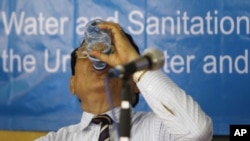While Cambodians are increasingly enjoying clean water, many who live in the poorer areas of the country remain at risk to diseases caused from dirty water, officials said Tuesday as they marked World Water Day.
Around 85 percent of Cambodians have access to safe drinking water, with the majority in urban areas, Douglas Broderick, the UN resident coordinator, said in an address at a Phnom Penh primary school.
But in urban slums, access to state water is limited, forcing many to pay three to five times the cost, he said. As a result, “many people in urban slums are forced to rely on unsafe water sources.”
Phnom Penh, which has earned high marks for creating access to water, has around 5,000 families in slum areas with free access to safe water under a World Bank program, said Man Chhoeun, deputy commissioner for development at the Council of Ministers.
“The water connection to each house in general costs $100,” he said. “The government policy subsidizes a connection to safe water service to the poor people to lower the price by 50 percent.”
Sok Sovannarith, secretary of state for the Ministry of Industry, said the government is aiming to have 80 percent of the population across the country, including 50 percent of the rural areas, with access to state supplied water. Currently, only about 60 percent of the population has access to such a water supply, he said.





